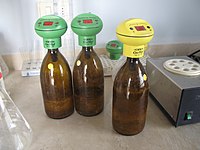
Photo from wikipedia
A novel procedure for nylon 6 and nylon 6,6 polyamide (PAs) microplastics (MPs) quantification is described for the first time. The overall procedure, including quantification of poly(ethylene terephthalate) (PET), was… Click to show full abstract
A novel procedure for nylon 6 and nylon 6,6 polyamide (PAs) microplastics (MPs) quantification is described for the first time. The overall procedure, including quantification of poly(ethylene terephthalate) (PET), was tested on wastewater treatment plant (WWTP) sludges. The three polymers account for the largest global share of synthetic textile microfibers, being possibly the most common MPs released upon laundering in urban wastewaters. Therefore, measuring their content in WWTP sludges may provide an accurate picture of the potential risks associated with both the inflow of these MPs in natural water bodies and the practice of using WWTP sludges as agricultural soil amendment. The novel procedure involves PAs depolymerization by acid hydrolysis followed by derivatization of the monomers 6-aminohexanoic acid (AHA) and hexamethylene diamine (HMDA) with a fluorophore. Reversed-phase HPLC analysis with fluorescence detection results in high sensitivities for both AHA (LOD = 8.85·10-4 mg/L, LOQ = 3.73·10-3 mg/L) and HMDA (LOD = 2.12·10-4, LOQ = 7.04·10-4 mg/L). PET quantification involves depolymerization, in this case by alkaline hydrolysis, followed by HPLC analysis of its comonomer terephthalic acid. Eight sludge samples from four WWTPs in Italy showed contamination in the 29.3-215.3 ppm and 10.6-134.6 ppm range for nylon 6 and nylon 6,6, respectively, and in the 520-1470 ppm range for PET.
Journal Title: Journal of hazardous materials
Year Published: 2020
Link to full text (if available)
Share on Social Media: Sign Up to like & get
recommendations!